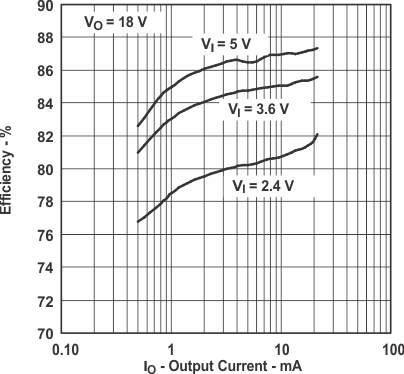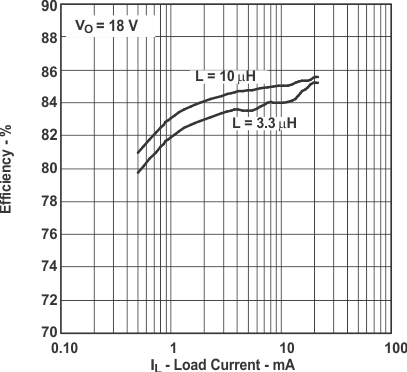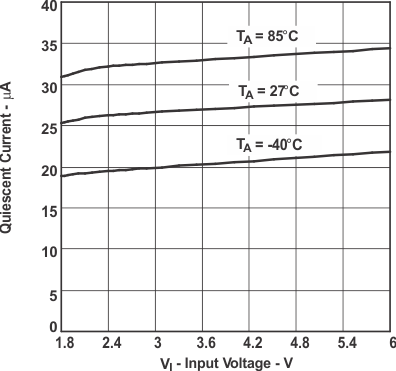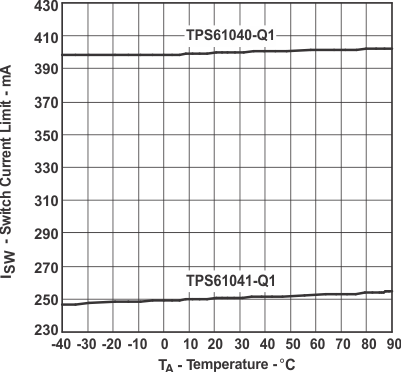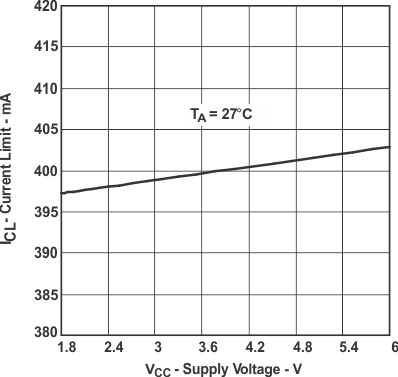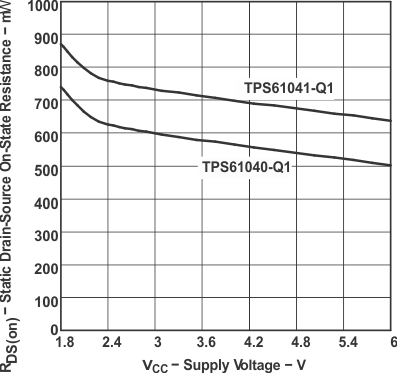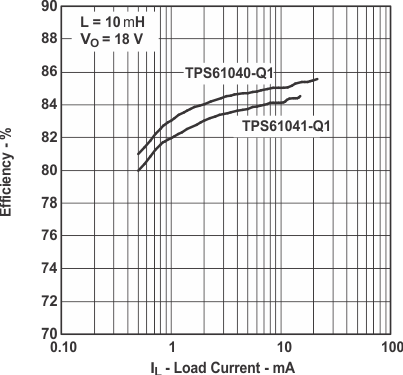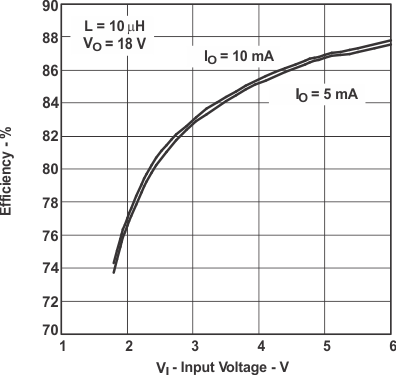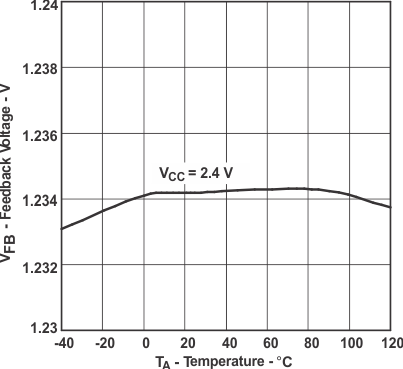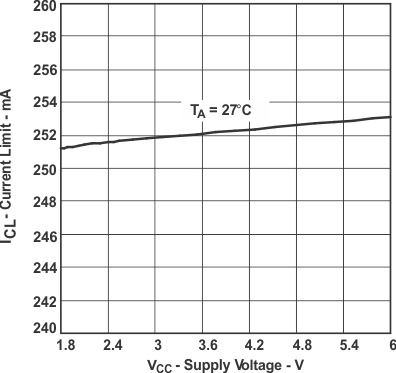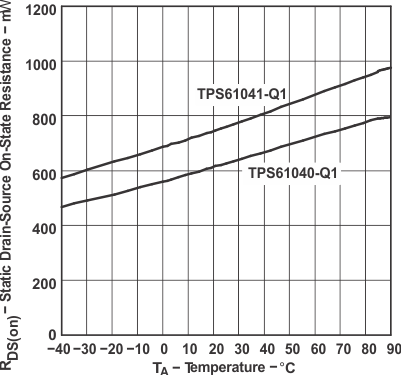SGLS276D January 2005 – March 2016 TPS61040-Q1 , TPS61041-Q1
PRODUCTION DATA.
- 1 Features
- 2 Applications
- 3 Description
- 4 Revision History
- 5 Pin Configuration and Functions
- 6 Specifications
- 7 Detailed Description
- 8 Application and Implementation
- 9 Power Supply Recommendations
- 10Layout
- 11Device and Documentation Support
- 12Mechanical, Packaging, and Orderable Information
Package Options
Refer to the PDF data sheet for device specific package drawings
Mechanical Data (Package|Pins)
- DBV|5
Thermal pad, mechanical data (Package|Pins)
Orderable Information
6 Specifications
6.1 Absolute Maximum Ratings
over operating free-air temperature range (unless otherwise noted)(1)| MIN | MAX | UNIT | ||
|---|---|---|---|---|
| Supply voltages on pin VIN (2) | –0.3 | 7 | V | |
| Voltages on pins EN, FB (2) | –0.3 | VIN + 0.3 | V | |
| Switch voltage on pin SW (2) | 30 | V | ||
| Continuous power dissipation | See Thermal Information | |||
| TJ | Operating junction temperature | –40 | 150 | °C |
| TStg | Storage temperature | –65 | 150 | °C |
(1) Stresses beyond those listed under Absolute Maximum Ratings may cause permanent damage to the device. These are stress ratings only, which do not imply functional operation of the device at these or any other conditions beyond those indicated under Recommended Operating Conditions. Exposure to absolute-maximum-rated conditions for extended periods may affect device reliability.
(2) All voltage values are with respect to network ground terminal.
6.2 ESD Ratings
| VALUE | UNIT | |||
|---|---|---|---|---|
| V(ESD) | Electrostatic discharge | Human-body model (HBM), per AEC Q100-002(1) | ±2000 | V |
| Charged-device model (CDM), per AEC Q100-011 | ±750 | |||
(1) AEC Q100-002 indicates that HBM stressing shall be in accordance with the ANSI/ESDA/JEDEC JS-001 specification.
6.3 Recommended Operating Conditions
| MIN | TYP | MAX | UNIT | ||
|---|---|---|---|---|---|
| VIN | Input voltage | 1.8 | 6 | V | |
| VOUT | Output voltage | 28 | V | ||
| L | Inductor(1) | 2.2 | 10 | 47 | μH |
| f | Switching frequency(1) | 1 | MHz | ||
| CIN | Input capacitor (1) | 4.7 | μF | ||
| COUT | Output capacitor (1) | 1 | μF | ||
| TA | Operating ambient temperature | –40 | 125 | °C | |
(1) See Application and Implementation section for further information.
6.4 Thermal Information
| THERMAL METRIC(1) | TPS6104x-Q1 | UNIT | |
|---|---|---|---|
| DBV (SOT-23) | |||
| 5 PINS | |||
| RθJA | Junction-to-ambient thermal resistance | 153.5 | °C/W |
| RθJC(top) | Junction-to-case (top) thermal resistance | 105.7 | °C/W |
| RθJB | Junction-to-board thermal resistance | 33.5 | °C/W |
| ψJT | Junction-to-top characterization parameter | 9.8 | °C/W |
| ψJB | Junction-to-board characterization parameter | 33.1 | °C/W |
(1) For more information about traditional and new thermal metrics, see the Semiconductor and IC Package Thermal Metrics application report, SPRA953.
6.5 Electrical Characteristics
VIN = 2.4 V, EN = VIN, TA = –40°C to 125°C, typical values are at TA = 25°C (unless otherwise noted)| PARAMETER | TEST CONDITIONS | MIN | TYP | MAX | UNIT | ||
|---|---|---|---|---|---|---|---|
| SUPPLY CURRENT | |||||||
| VIN | Input voltage range | 1.8 | 6 | V | |||
| IQ | Operating quiescent current | IOUT = 0 mA, not switching, VFB = 1.3 V | 28 | 50 | μA | ||
| ISD | Shutdown current | EN = GND | 0.1 | 1 | μA | ||
| VUVLO | Undervoltage lockout threshold | 1.5 | 1.7 | V | |||
| ENABLE | |||||||
| VIH | EN high level input voltage | 1.3 | V | ||||
| VIL | EN low level input voltage | 0.4 | V | ||||
| II | EN input leakage current | EN = GND or VIN | 0.1 | 1 | μA | ||
| POWER SWITCH AND CURRENT LIMIT | |||||||
| Vsw | Maximum switch voltage | 30 | V | ||||
| toff | Minimum OFF time | 250 | 400 | 550 | ns | ||
| ton | Maximum ON time | 4 | 6 | 7.5 | μs | ||
| RDS(on) | MOSFET ON-resistance | VIN = 2.4 V; ISW = 200 mA; TPS61040-Q1 | 600 | 1100 | mΩ | ||
| RDS(on) | MOSFET ON-resistance | VIN = 2.4 V; ISW = 200 mA; TPS61041-Q1 | 750 | 1300 | mΩ | ||
| MOSFET leakage current | VSW = 28 V | 1 | 10 | μA | |||
| ILIM | MOSFET current limit | TPS61040-Q1 | 325 | 400 | 500 | mA | |
| ILIM | MOSFET current limit | TPS61041-Q1 | 200 | 250 | 325 | mA | |
| OUTPUT | |||||||
| VOUT | Adjustable output voltage range(2) | VIN | 28 | V | |||
| Vref | Internal voltage reference | 1.233 | V | ||||
| IFB | Feedback input bias current | VFB = 1.3 V | 1 | μA | |||
| VFB | Feedback trip point voltage | 1.8 V ≤ VIN ≤ 6 V | TJ = –40°C to 85°C | 1.208 | 1.233 | 1.258 | V |
| TJ = –40°C to 125°C | 1.2 | 1.233 | 1.27 | ||||
| Line regulation (1) | 1.8 V ≤ VIN ≤ 6 V; VOUT = 18 V; Iload = 10 mA; CFF = not connected |
0.05 | %/V | ||||
| Load regulation(1) | VIN = 2.4 V; VOUT = 18 V; 0 mA ≤ IOUT ≤ 30 mA | 0.15 | %/mA | ||||
(1) The line and load regulation depend on the external component selection. See Application and Implementation for further information.
(2) Cannot be production tested. Assured by design.
6.6 Typical Characteristics
Table 1. Table of Graphs
| FIGURE | |||
|---|---|---|---|
| η | Efficiency | vs Load current | Figure 1, Figure 2, Figure 3 |
| vs Input voltage | Figure 4 | ||
| IQ | Quiescent current | vs Input voltage and temperature | Figure 5 |
| VFB | Feedback voltage | vs Temperature | Figure 6 |
| ISW | Switch current limit | vs Temperature | Figure 7 |
| ICL | Switch current limit | vs Supply voltage, TPS61041-Q1 | Figure 8 |
| vs Supply voltage, TPS61040-Q1 | Figure 9 | ||
| RDS(on) | RDS(on) | vs Temperature | Figure 10 |
| vs Supply voltage | Figure 11 | ||
| Line transient response | Figure 13 | ||
| Load transient response | Figure 14 | ||
| Start-up behavior | Figure 15 | ||
